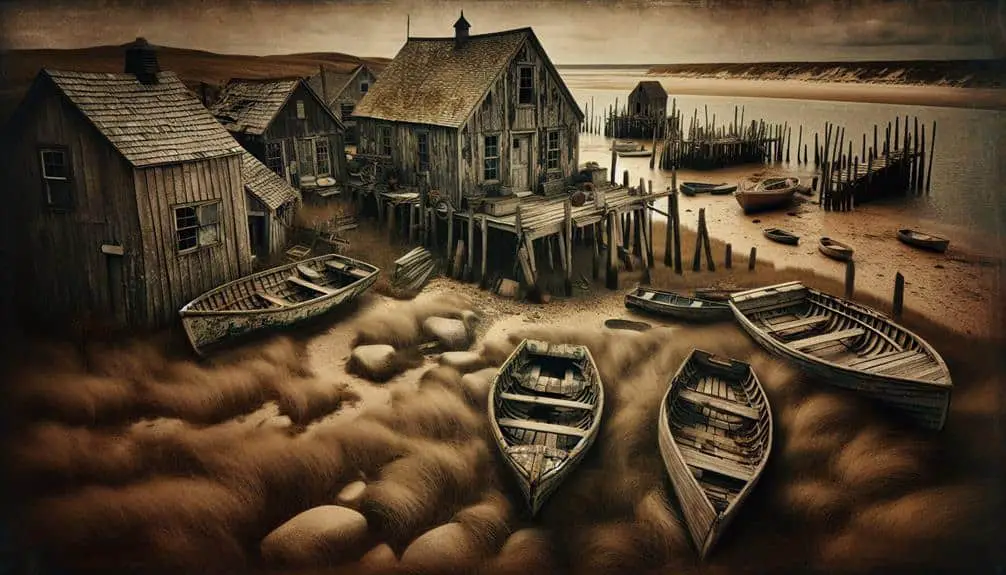Fishing villages in America vanished due to industrial changes, environmental shifts, and industry decline. These led to economic struggles and loss of cultural heritage in coastal areas. Industrialization altered traditional fishing practices, making small enterprises less profitable. Climate change brought rising sea levels and ecosystem changes, displacing communities. Fishing industry decline due to overfishing and competition caused job losses and economic viability problems. Efforts are needed to address challenges and revitalize the industry. Preservation projects celebrate unique identities and traditions. Understanding the reasons behind the disappearance can shed light on the complexities faced by coastal communities.
Key Points
- Economic struggles due to overfishing, stricter regulations, and industrial competition.
- Rising costs and decreasing fish stocks impacting profitability of fishing villages.
- Demographic shifts with younger generations migrating for better opportunities.
- Environmental changes like rising sea levels and altered ecosystems displacing communities.
- Urgent need for sustainable environmental practices and adaptive strategies to address challenges.
Historical Significance of Fishing Villages
The historical importance of fishing villages lies in their pivotal role in shaping coastal economies and cultural identities throughout American history. Fishing villages have long been the bedrock of cultural traditions, passing down techniques and knowledge from generation to generation. These tight-knit communities not only relied on the sea for sustenance but also for economic dependence. The fishing industry provided jobs, sustained local businesses, and contributed greatly to the overall prosperity of coastal regions.
Cultural traditions in fishing villages were deeply intertwined with the rhythms of the sea. Practices like boat-building, net-making, and fish processing weren't just economic activities but also a way of life, preserving a rich heritage that connected people to their past. The economic dependence on fishing meant that changes in the industry could have profound effects on the entire community. When fish stocks dwindled or markets shifted, the very fabric of these villages could be shaken, leading to economic hardships and a loss of cultural identity.
Impact of Industrialization on Coastal Communities
Industrialization has greatly altered the landscape and livelihoods of coastal communities in America. The advent of industrialization brought about significant economic shifts in these regions. Traditional fishing practices, once the mainstay of coastal communities, faced competition from large-scale industrial fishing operations. This led to a decline in the profitability of small-scale fishing enterprises, forcing many villagers to seek alternative sources of income.
The social consequences of industrialization on coastal communities were profound. As jobs in fishing became scarcer, younger generations began to migrate to urban areas in search of better opportunities. This resulted in a demographic shift, with many fishing villages experiencing a decline in population. The close-knit community bonds that had been forged over generations started to weaken as families were separated by economic necessity.
Environmental Changes and Disappearing Villages
As coastal ecosystems underwent significant transformations due to human activities, the environmental changes precipitated a chain reaction leading to the disappearance of fishing villages in America. Climate change, driven by factors like greenhouse gas emissions and deforestation, has resulted in rising sea levels, increased ocean acidity, and altered marine ecosystems. These changes have directly impacted the livelihoods of fishing communities dependent on the delicate balance of coastal environments.
Community displacement has been a direct consequence of these environmental shifts. As sea levels rise and storms intensify due to climate change, coastal fishing villages face increasing risks of flooding and erosion, making them unsustainable for human habitation. In response, many residents have been forced to abandon their homes and traditional ways of life, seeking refuge in more stable inland regions.
The interplay between climate change and community displacement highlights the urgent need for sustainable environmental practices and adaptive strategies to protect coastal communities. Without proactive measures to mitigate the impact of environmental changes, the disappearance of fishing villages in America is likely to continue unabated.
Decline in Fishing Industry and Population
Amidst shifting environmental conditions and societal factors, the fishing industry and population in America are experiencing a notable decline. The population decline in fishing communities can be attributed to various economic struggles faced by fishermen. According to recent data, many fishing villages have seen a significant decrease in residents as job opportunities dwindle due to overfishing, stricter regulations, and increased competition from industrial fishing operations.
In addition to the decline in population, the fishing industry itself is facing challenges. Economic struggles such as rising costs of equipment, fuel, and maintenance, coupled with decreasing fish stocks, have led to a decrease in the number of active fishing vessels and a drop in overall catch rates. These factors have contributed to a downward trend in the economic viability of small-scale fishing operations, further exacerbating the population decline in these once-thriving communities.
To reverse this trend, concerted efforts are needed to address the economic challenges faced by fishermen and revitalize the fishing industry to secure the sustainability of these coastal communities.
Preservation Efforts and Cultural Heritage
Preservation efforts and cultural heritage play a crucial role in safeguarding the traditional way of life and historical significance of fishing communities in America. Without these initiatives, the rich cultural traditions and unique identities of these villages risk being lost to modernization and urbanization.
Here are three key aspects of preservation initiatives and cultural traditions in fishing villages:
- Historic Preservation: Preserving old fishing structures such as docks, houses, and boats helps maintain the authenticity of these communities and provides a tangible link to their past.
- Cultural Festivals: Organizing events that celebrate the history, music, cuisine, and crafts of fishing villages not only educates the public but also instills pride in the local residents about their heritage.
- Oral History Projects: Capturing the stories and experiences of elder fishermen through interviews and recordings ensures that their knowledge is passed down to future generations, keeping alive the wisdom and traditions of these communities.
Frequently Asked Questions
How Did the Introduction of Commercial Fishing Regulations Impact the Decline of Fishing Villages in America?
When commercial fishing regulations were introduced, they impacted fishing villages in America by restricting traditional practices, causing economic changes. These regulations led to declining populations and disappearing villages as livelihoods were affected.
What Role Did Changing Consumer Preferences Play in the Disappearance of Fishing Villages?
Changing diets and sustainability trends have greatly impacted the disappearance of fishing villages in America. As consumer preferences evolved towards different seafood options, traditional fishing communities struggled to adapt, leading to their decline.
How Have Advancements in Technology Affected the Fishing Industry and Contributed to the Decline of Traditional Fishing Villages?
Advancements in technology have revolutionized the fishing industry. Automation and innovation brought efficiency, but at a cost. Traditional fishing villages dwindled as machines replaced hands, altering the once intimate connection between fishermen and the sea.
What Are Some Unique Cultural Practices or Traditions That Were Once Common in Fishing Villages but Have Since Disappeared?
You may find that traditional celebrations and folklore stories once thrived in fishing villages, offering a rich tapestry of cultural practices. Over time, these unique customs have faded, leaving behind memories of a bygone era.
How Have Government Policies and Subsidies Influenced the Decline of Fishing Villages in America?
When government policies favoring large-scale fishing operations over small villages are enacted, subsidies can amplify economic disparities. Communities face displacement as local economies erode. Such influences have hastened the decline of fishing villages in America.



